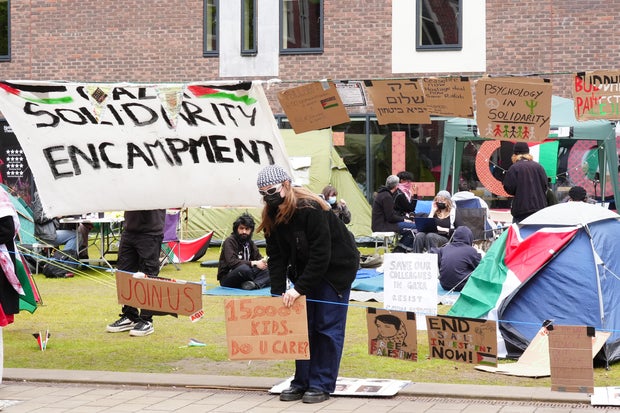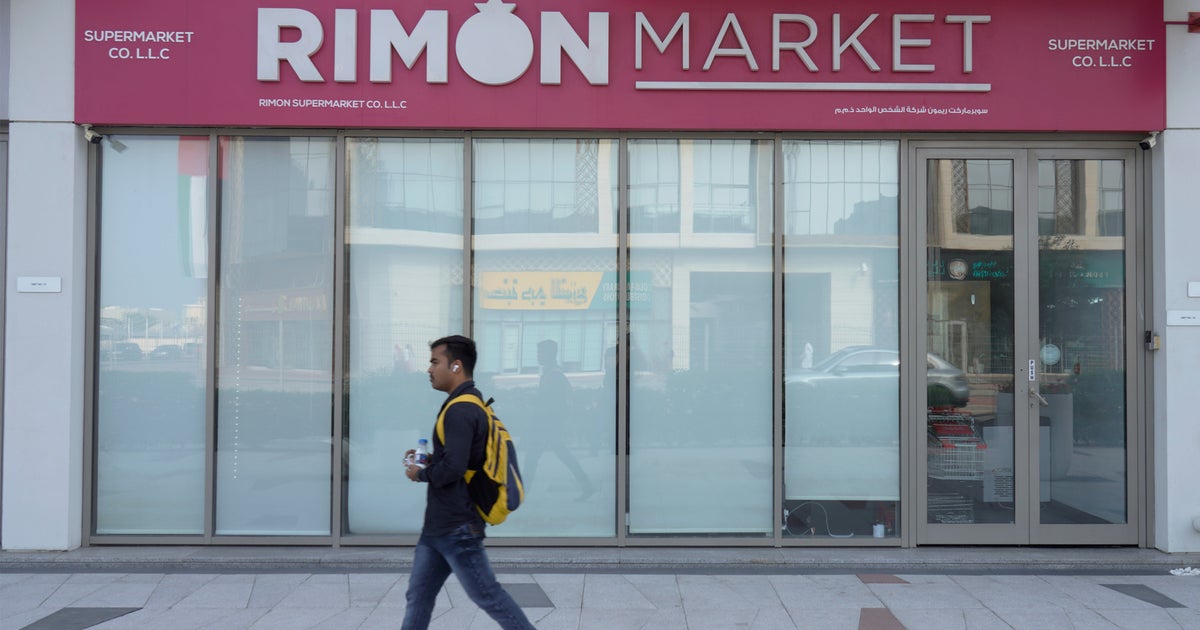CBS News
Where pro-Palestinian university protests are happening around the world

London — Protests in solidarity with Palestinians amid Israel’s ongoing war with Hamas in the Gaza Strip have swept across college campuses in the United States in recent weeks, but they’ve also spread rapidly around the world.
Demonstrations have cropped up on campuses at major universities across the Arab and Western world as the war grinds on. Below is a look at where some of the larger protests have taken shape.
Lebanon
In Lebanon, hundreds of students gathered at university campuses across the country’s capital Beirut this week. Video posted online from the American University of Beirut showed demonstrators waving Palestinian flags and posters emblazoned with messages demanding the university cut all business ties with Israel.
“This is not just about Palestinians, of course — it is, but it’s also about what’s happening to us in our own country,” Karine Ballout, a 23-year-old Lebanese student at the university, told CBS News on Thursday. “We are asking for the immediate end to the U.S.-backed Israeli genocide on the Palestinians, and also for the immediate end of the U.S.-backed Israeli aggressions on Lebanon.”
Israel has exchanged fire with the Lebanon-based Hezbollah group, a Hamas ally that’s also backed by Iran, since the war started on Oct. 7. The war was sparked by Hamas’ terrorist attack on Israel that killed some 1,200 people and saw the militants seize about 240 others as hostages. There are still 100 people, including five U.S. nationals, believed to be alive and captive in Gaza.
Fadel Itani/NurPhoto via Getty Images
“Of course we were inspired by the protests in the U.S., and Columbia University in particular,” Rayyan Kilani, 21, a student at the American University, told the Reuters news agency.
Jordan
Thousands of protesters have also demonstrated in Jordan, which, like Lebanon, borders Israel, in solidarity with Palestinians since the war broke out, including university students.
Jordanian authorities have cracked down on university activists over the past seven months of the war, however, and activists called off a sit-in that had been planned for Tuesday at Jordan University in Amman, Reuters reported.
DAWN, an organization focused on human rights in the Middle East, has said at least nine students have been arrested and five expelled or suspended for participating in pro-Palestinian demonstrations in Jordan since Oct. 7.
“While King Abdullah is loudly protesting the war in Gaza to the international community, he’s not allowing Jordanians the same right to express their own views,” said DAWN’s Senior Consultant Jamal Al Tahat in a March press release.
United Kingdom
Mass demonstrations have taken place on university campuses across the U.K. since the war began, including at Oxford University, Newcastle University, Warwick University and University College London, among others.
Owen Humphreys/PA Images via Getty Images
At University College London, protesters have called for the school to sever its link with Tel Aviv University and to cut all economic ties with weapons manufacturers they say are supporting Israel’s war effort.
“Our demands are basically to demand of UCL to end its complicity in what we see as a genocide in Gaza … to demand an academic boycott because Tel Aviv, like many other Israeli universities, is embedded in the Israeli military establishment,” Bushra, a 24-year-old UCL master’s student who only gave her first name, told CBS News on Thursday. “UCL has collaborations with BAE Systems, with Lockheed Martin — there has been no statement about the ethical nature of these partnerships.”
Bushra said she stood in solidarity with U.S. protesters as they face police crackdowns on some campuses, but she stressed that the focus should be on Gaza.
“Activists at Columbia have said the same thing,” she told CBS News. “Whatever oppression they face is not the tiniest fraction of the suffering that the people in Palestine are facing.”
France
At France’s renowned Sciences Po Paris university, protesters have clashed with riot police over the last week, with several dozen officers entering the school to clear out about 60 protesters who had set up an encampment, according to Le Monde newspaper.
Sameer Al-Doumy/AFP via Getty Images
On Wednesday, the Sciences Po Palestine Committee, which has organized the protests, posted a map showing where protests against the war in Gaza were scheduled at universities across France.
“While American universities’ students are being repressed, the movement is spreading throughout France,” the group said in its Instagram post.
Australia
Sit-in college protests have also popped up in the Australian cities of Sydney, Melbourne, Adelaide and the capital Canberra, according to the Australian Broadcasting Corp., mirroring the tent camps on U.S. universities.
Australian students have also called for their universities to divest from Israel and disclose and cut ties with weapons manufacturers that do business with Israel, the Australian national broadcaster said.
As on some U.S. campuses, there have been reports of antisemitism amid the protests at universities across Australia.
On Wednesday, the Australian Union of Jewish Students said that, since the outbreak of the war, “Jewish students have been targeted at university events and demanded to declare their political stances during classes publicly,” adding its concern that, “we are witnessing a further escalation in the vilification of Jewish students.”
Canada
Closer to the chaos unfolding in the U.S., student protesters set up a camp on a common at the University of Toronto’s campus, Canadian national broadcaster CBC reported Thursday.
Mert Alper Dervis/Anadolu via Getty Images
Activists there issued similar demands for their university to divest from assets that “sustain Israeli apartheid, occupation and illegal settlement of Palestine,” according to CBC News.
CBS News
In praise of Seattle-style teriyaki

Watch CBS News
Be the first to know
Get browser notifications for breaking news, live events, and exclusive reporting.
CBS News
Gazan chefs cook up hope and humanity for online audience

Renad Atallah is an unlikely internet sensation: a 10-year-old chef, with a repertoire of simple recipes, cooking in war-torn Gaza. She has nearly a million followers on Instagram, who’ve witnessed her delight as she unpacks parcels of food aid.
CBS News
We interviewed Renad via satellite, though we were just 50 miles away, in Tel Aviv. [Israel doesn’t allow outside journalists into Gaza, except on brief trips with the country’s military.]
“There are a lot of dishes I’d like to cook, but the ingredients aren’t available in the market,” Renad told us. “Milk used to be easy to buy, but now it’s become very expensive.”
I asked, “How does it feel when so many people like your internet videos?”
“All the comments were positive,” she said. “When I’m feeling tired or sad and I want something to cheer me up, I read the comments.”
We sent a local camera crew to Renad’s home as she made Ful, a traditional Middle Eastern bean stew. Her older sister Noorhan says they never expected the videos to go viral. “Amazing food,” Noorhan said, who added that her sibling made her “very surprised!”
After more than a year of war, the Gaza Strip lies in ruins. Nearly everyone has been displaced from their homes. The United Nations says close to two million people are experiencing critical levels of hunger.
Hamada Shaqoura is another chef showing the outside world how Gazans are getting by, relying on food from aid packages, and cooking with a single gas burner in a tent.
Shaqoura also volunteers with the charity Watermelon Relief, which makes sweet treats for Gaza’s children.
In his videos online, Shaqoura always appears very serious. Asked why, he replied, “The situation does not call for smiling. What you see on screen will never show you how hard life is here.”
Before dawn one recent morning in Israel, we watched the UN’s World Food Program load nearly two dozen trucks with flour, headed across the border. The problem is not a lack of food; the problem is getting the food into the Gaza Strip, and into the hands of those who desperately need it.
The UN has repeatedly accused Israel of obstructing aid deliveries to Gaza. Israel’s government denies that, and claims that Hamas is hijacking aid.
“For all the actors that are on the ground, let the humanitarians do their work,” said Antoine Renard, the World Food Program’s director in the Palestinian territories.
I asked, “Some people might see these two chefs and think, well, they’re cooking, they have food.”
“They have food, but they don’t have the right food; they’re trying to accommodate with anything that they can find,” Renard said.
Even in our darkest hour, food can bring comfort. But for many in Gaza, there’s only the anxiety of not knowing where they’ll find their next meal.
For more info:
Story produced by Mikaela Bufano. Editor: Carol Ross.
See also:
“Sunday Morning” 2024 “Food Issue” recipe index
Delicious menu suggestions from top chefs, cookbook authors, food writers, restaurateurs, and the editors of Food & Wine magazine.
CBS News
A study to devise nutritional guidance just for you

It’s been said the best meals come from the heart, not from a recipe book. But at this USDA kitchen, there’s no pinch of this, dash of that, no dollops or smidgens of anything. Here, nutritionists in white coats painstakingly measure every single ingredient, down to the tenth of a gram.
Sheryn Stover is expected to eat every crumb of her pizza; any tiny morsels she does miss go back to the kitchen, where they’re scrutinized like evidence of some dietary crime.
Stover (or participant #8180, as she’s known) is one of some 10,000 volunteers enrolled in a $170 million nutrition study run by the National Institutes of Health. “At 78, not many people get to do studies that are going to affect a great amount of people, and I thought this was a great opportunity to do that,” she said.
CBS News
It’s called the Nutrition for Precision Health Study. “When I tell people about the study, the reaction usually is, ‘Oh, that’s so cool, can I do it?'” said coordinator Holly Nicastro.
She explained just what “precise” precisely means: “Precision nutrition means tailoring nutrition or dietary guidance to the individual.”
The government has long offered guidelines to help us eat better. In the 1940s we had the “Basic 7.” In the ’50s, the “Basic 4.” We’ve had the “Food Wheel,” the “Food Pyramid,” and currently, “My Plate.”
CBS News
They’re all well-intentioned, except they’re all based on averages – what works best for most people, most of the time. But according to Nicastro, there is no one best way to eat. “We know from virtually every nutrition study ever conducted, we have inner individual variability,” she said. “That means we have some people that are going to respond, and some people that aren’t. There’s no one-size-fits-all.”
The study’s participants, like Stover, are all being drawn from another NIH study program called All Of Us, a massive undertaking to create a database of at least a million people who are volunteering everything from their electronic health records to their DNA. It was from that All of Us research that Stover discovered she has the gene that makes some foods taste bitter, which could explain why she ate more of one kind of food than another.
Professor Sai Das, who oversees the study at Tufts University, says the goal of precision nutrition is to drill down even deeper into those individual differences. “We’re moving away from just saying everybody go do this, to being able to say, ‘Okay, if you have X, Y and Z characteristics, then you’re more likely to respond to a diet, and somebody else that has A, B and C characteristics will be responding to the diet differently,'” Das said.
It’s a big commitment for Stover, who is one of 150 people being paid to live at a handful of test sites around the country for six weeks – two weeks at a time. It’s so precise she can’t even go for a walk without a dietary chaperone. “Well, you could stop and buy candy … God forbid, you can’t do that!” she laughed.
While she’s here, everything from her resting metabolic rate, her body fat percentage, her bone mineral content, even the microbes in her gut (digested by a machine that essentially is a smart toilet paper reading device) are being analyzed for how hers may differ from someone else’s.
Nicastro said, “We really think that what’s going on in your poop is going to tell us a lot of information about your health and how you respond to food.”
CBS News
Stover says she doesn’t mind, except for the odd sounds the machine makes. While she is a live-in participant, thousands of others are participating from their homes, where electronic wearables track all kinds of health data, including special glasses that record everything they eat, activated when someone starts chewing. Artificial intelligence can then be used to determine not only which foods the person is eating, but how many calories are consumed.
This study is expected to be wrapped up by 2027, and because of it, we may indeed know not only to eat more fruits and vegetables, but what combination of foods is really best for us. The question that even Holly Nicastro can’t answer is, will we listen? “You can lead a horse to water; you can’t make them drink,” she said. “We can tailor the interventions all day. But one hypothesis I have is that if the guidance is tailored to the individual, it’s going to make that individual more likely to follow it, because this is for me, this was designed for me.”
For more info:
Story produced by Mark Hudspeth. Editor: Ed Givnish.
“Sunday Morning” 2024 “Food Issue” recipe index
Delicious menu suggestions from top chefs, cookbook authors, food writers, restaurateurs, and the editors of Food & Wine magazine.
















